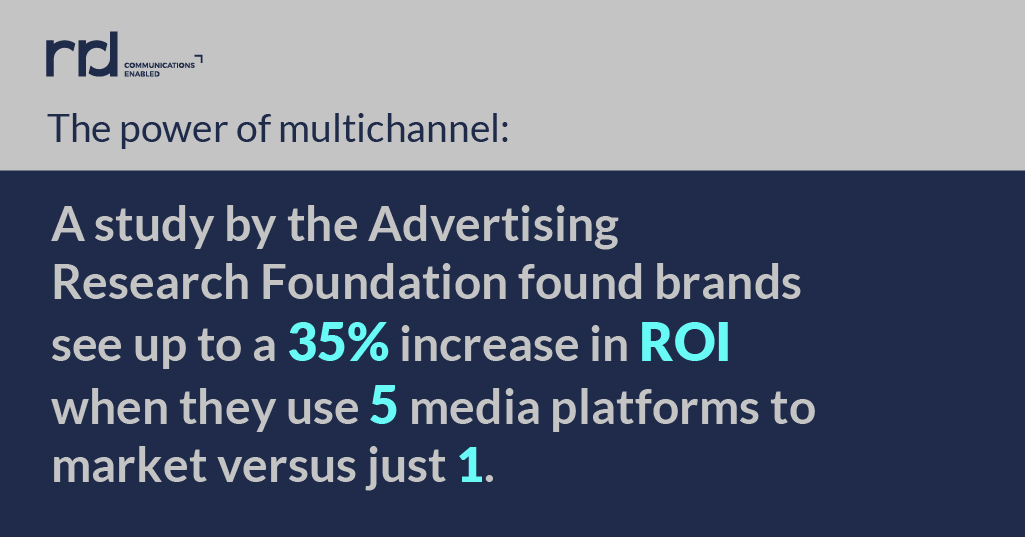Multichannel Marketing 101: What is Multichannel Marketing and Why Is It So Important for Engaging Customers?
1/3/2018 RRD

If you’ve been paying attention to marketing buzzwords the past few years, you’ve more than likely heard of “multichannel marketing,” but might not be sure exactly what it is. Even if you haven’t heard of it, you might be surprised to learn that you’re likely engaging in multichannel marketing already, simply because the common tools are at your disposal (email, print, social, etc.). However, successful use of multichannel marketing requires a firm grasp of this marketing concept and its potential challenges. Employing a few best practices will transform haphazard multichannel marketing into an ROI powerhouse for your company.
Multichannel marketing defined
Multichannel marketing refers to a brand’s efforts to interact with its customers across multiple platforms, or “channels,” in an effort to grow customer engagement. In other words, within a single campaign, marketers rely on a mix of direct marketing (i.e. print ads, TV/radio, direct mail) and indirect marketing (like social media or blogging). You might have also heard of “omnichannel marketing,” which, while similar to multichannel, is more focused on ensuring the customer has a seamless experience with your brand — think e-shopping carts that move between devices with the customer, email reminders to check out, etc.
Growing “engagement” could equal increased sales or new donors. Whatever your metric, multichannel marketing — when executed well — is a powerful tool your organization can use to increase conversions. However, there’s a flip side: multichannel marketing, when executed poorly, can tank your efforts and result in confused, alienated customers.
Multichannel marketing — when executed well — is a powerful tool your organization can use to increase conversions … Multichannel marketing, when executed poorly, can tank your efforts and result in confused, alienated customers.
With multichannel marketing, the customer is in control of how he or she interacts with your brand. The key is to have a good strategy driving your multichannel efforts so you’re guiding the customer’s choice to your predetermined goal.
Why multichannel marketing strategy is so powerful
According to statistics from the Advertising Research Foundation, companies see up to a 35% increase in ROI when they use five media platforms to market versus just one. Think about it this way: In a tight, well-targeted multichannel campaign, your customers will see your marketing message multiple times across different mediums — the same message, but optimized for the medium at hand. To illustrate, let’s take a look at a multichannel marketing campaign example. Let’s say you’re introducing a new menu item at a fast food restaurant. You might:
- Tease the menu item’s debut with a sponsored Instagram stories campaign.
- Produce a traditional TV and/or radio commercial about the new item.
- Send coupons via text message to your subscription list. (Did you know text messages have a 98% open rate?)
- Send a personalized direct mail coupon, including the recipient’s nearest location.
- Share taste-test videos on Facebook.
- Contract with influencers to review your new item on their blogs. (Just remember FTC guidelines.)
- Post point-of-sale displays about the new product in your restaurant.

The old rule was that a consumer needed seven touches before acting upon a call to action, but in today’s info-saturated world, 13 or more touches might be necessary, according to the website Social Media Today . However, that number might be less for a low-cost consumable versus a car for instance. If your target customers see your new product when they log into Facebook and scroll through Instagram, and then see it in editorial copy, they’re more likely to remember it — so long as they experience a single message optimized for each individual placement.
And that’s where the challenge comes in.
Why multichannel marketing is so hard
Most of the hiccups marketers encounter with their multichannel marketing efforts can be chalked up to three age-old challenges: outdated technology, organizational silos, and sloppy analytics. Let’s tackle these problem areas one by one.
Outdated technology
The software company Episerver offers two multichannel stats of concern: 49% of marketers have to go to IT to add or update content to their websites — and 51% consider themselves unable to respond to new technologies because of their legacy tech systems.
This is a tough one. The “right” technology will require an investment from your company — plus you might be dealing with some interdepartmental territory issues. What you have to pitch to your boss is the importance of the customer’s experience. To be successful, a multichannel campaign should always have the same message and the same tone and feel like it’s coming from the same place. It’s easiest to provide a consistent experience when you can manage all channels in one system. And it’s easiest to react to changing conditions in today’s fast-paced world when you hold the keys — not IT.
To be successful, a multichannel campaign should always have the same message and the same tone … It’s easiest to provide a consistent experience when you can manage all channels in one system.
Organizational silos
We’ve touched on the relationship between marketing and IT, but even within marketing departments there can be silos. If different teams handle individual tasks, such as emails, social, and analytics, it’s important to make a concerted effort to keep everyone on the same page and on the same message. Check the egos if you want multiple departments to successfully execute a multichannel strategy.
Sloppy analytics
In the old days, it was easier to give credit where it was due. But now, how do you know what to credit for a successful conversion? Was the text message promotion the customer’s deciding factor, or was it the Facebook contest? Once again, your best shot at having comprehensive and useful analytics is to store your data in a single system accessible by all stakeholders. The goal is to have a single view of the customer and to correctly attribute touchpoints to the right channel.
Whether your foray into multichannel marketing is extensive (investment in new technology) or simple (ensuring social copy has the same tone as print copy), set yourself up for success by starting and ending your strategizing with your customer in mind. Manage the journey, not the touchpoints.
How can we help you create multichannel marketing and communications? Contact us.
This post was originally published January 3, 2018.